Life with Invisalign: Eating, Cleaning, and Smiling with Confidence

Invisalign treatment has become a popular option for individuals looking to straighten their teeth without the discomfort and appearance of traditional metal braces. The clear aligners are practical, comfortable, and virtually invisible, making them an attractive choice for both adults and teens. However, while Invisalign offers numerous advantages, it does require some lifestyle adjustments. Knowing how to adapt to these changes—eating with aligners, properly cleaning them, and sustaining confidence—can guarantee the success of your treatment.
What Is Invisalign and How Does It Work?
Invisalign treatment gradually shifts your teeth with a series of clear, custom-made aligners every 1 to 2 weeks. These aligners are made of a smooth plastic, making them more comfortable than metal braces, and they are almost invisible when worn. Most of the time, the aligners fit snugly over your teeth, but you will notice a shift when it is time to replace them.
One of the most significant advantages of Invisalign treatment is its removability. Unlike traditional braces, you can remove the aligners when eating, drinking, brushing, or flossing, resulting in fewer dietary restrictions and easier teeth cleaning.
Eating with your Invisalign aligners might seem challenging at first.
When Invisalign treatment starts, one of the first habits you'll have to get used to is taking out your aligners before meals and beverages, except water, as while you eat, you may trap food in your aligners and increase the likelihood of bacteria growth, resulting in staining the aligners and possibly causing damage to your aligners that may increase the length of your treatment time and harm your teeth in the process.
Although adjusting to the habit of taking out aligners pre-meal is a small behavior change, it is certainly understandable. Once you've eaten, you must clean your teeth to prevent bacterial growth or cavities and to ensure treatment progress. Rinse, brush, and floss to clean any food particles before replacing your aligners. You must keep this area bacteria-free to ensure there are no distractions in your treatment.
By adopting this habit, you can enjoy your favorite foods without compromising your treatment. Every step makes it easier to maintain your habits and keep your aligners clean.
Cleaning Your Invisalign Aligners and Your Teeth
As part of your Invisalign treatment, it's essential to maintain the cleanliness of both your Invisalign aligners and your teeth. Regular cleaning keeps your aligners clear and working, and your aligners and teeth free of any oral health problems such as plaque, cavities, and other nasty things.
To clean your aligners, rinse them with lukewarm water every time you take them out. Once a day, you should use a soft toothbrush with a bit of mild soap or use a cleaning solution made for Aligners. Do not use toothpaste. It is too abrasive and will add scratches, which will make your aligners more visible. Also, you should clean your teeth thoroughly after each meal to prevent any food from being stuck to your aligners.
Throughout this treatment, keep your teeth and gums healthy by brushing at least twice a day and flossing at least once a day. Invisalign works best with clean aligners and healthy teeth.
Keeping up Confidence when Using Invisalign
People often worry that aligners during Invisalign treatment might affect their appearance or speech. Worry not. Invisalign aligners are clear, which makes them hard to notice. Most people won't see that you are wearing them unless you tell them. Patients, however, report having a mild lisp when they start the treatment. It is a passage that will fade within the days, as aligners become part of your everyday life.
Try speaking or reading out loud to adjust if you feel anxious or self-conscious. It will help you adjust to the aligners and your mouth, giving you confidence in your new appearance. The smile will compensate for altered speech and mild discomfort, ultimately resulting in self-confidence.
With Invisalign, you can straighten your teeth while avoiding the feelings of self-consciousness that come with traditional braces, so that you can smile in public without worry.
What Will Happen during Your Invisalign Check-ins?
Invisalign treatment is monitored every six to eight weeks by a dentist or orthodontist to assess progress and determine proper fit. Each of these interactions is like a touchpoint. Your dentist will observe the degree of movement in the teeth and prepare the next set of aligners. Depending on the changes in the teeth's alignment during these touchpoints, the dentist may adapt the treatment approach.
The distance to the next appointment may raise concerns or cause discomfort, however. Your dentist will likely discuss any discomfort or issues with the aligners during your appointments, as they may need to be adjusted.
Every treatment is different, and with your dentist's coaching, you will be able to reach your desired orthodontic outcome.
FAQs
1. How long does an individual Invisalign treatment take?
Invisalign treatment depends on the complexity of the case at hand, with an average treatment lasting about 12 to 18 months. However, certain cases may be completed in a shorter or longer time.
2. Can I drink with my aligners on?
While wearing aligners, drinking anything other than water is discouraged because it can cause staining or damage. Drinks with sugar, coffee, or tea can cause aligners to stain and lead to bacterial growth.
3. How often do I need to wear my Invisalign aligners?
To achieve the desired outcome, wear the aligners for 20 to 22 hours daily, removing them only to eat, drink, or clean your teeth.
4. Will Invisalign affect my speech?
Some people notice a slight lisp at first, but it usually goes away quickly. This is no cause for concern, and you are familiar with new aligners.
5. Can I eat anything I want with Invisalign?
Absolutely! As long as you take your aligners off before you eat, you can eat anything you want. Just clean your teeth before you replace the aligners.
With Invisalign treatment, you can straighten your teeth easily without significantly impacting your daily routine. Life with Invisalign can be smooth, seamless, and enjoyable with a few simple steps: removing your aligners before meals, cleaning them and your teeth regularly, and maintaining a positive attitude. Over time, you will achieve a new, straighter smile with confidence.






